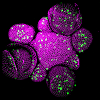
The Department of Engineering’s Design and Technical Services team will bring mathematical beauty to life with a Fibonacci spiral wall, designed and built for the Sainsbury Laboratory Cambridge exhibit at the RHS Chelsea Flower Show (20-24 May, 2025).
We have been able to push the boundaries of traditional fabrication techniques to create something both visually captivating and mathematically accurate.
Thomas Glenday
The Sainsbury Laboratory Cambridge: Blooming Numbers exhibit is inspired by mathematical principles found in nature – in this case the Fibonacci sequence[1] – a mathematical pattern that also fascinated famous Cambridge alums Charles Darwin and Alan Turing.
As part of the Show's new GreenSTEM section, which showcases research, technology and innovation in plant science and horticulture, the interactive exhibit will provide visitors with an insight into the modern plant science research techniques and technologies that Sainsbury Laboratory scientists use to unlock the complexity of plants.
A Fibonacci spiral will be the central element and will guide visitors through a journey along the plant life cycle starting with THE FLOWER. Visitors will follow a circular route around a double-sided spiral wall. This immersive design not only showcases the wonders of plants but also engages visitors in understanding the relationship between mathematics and the natural world.
Turning an idea into reality
Starting with the initial idea of the Fibonacci sequence, Thomas Glenday, Head of Design and Technical Services at the Department of Engineering, took on the challenge of designing a curved structure in metal and wood to bring to life the Fibonacci spiral wall.
Thomas has worked with his team to translate the vision into reality using clever engineering design techniques, while also staying true to the mathematics of the Fibonacci sequence.
"The design of the wall requires a balance between artistic vision and engineering precision,” he said. “The Fibonacci sequence is not just a series of numbers; it's a natural pattern that exists in everything from shells to galaxies. Bringing that to life in metal and wood requires careful consideration of form, material, and technique that is both beautiful and structurally sound.
"One of the most exciting aspects of this project is collaborating with my team. We have been able to push the boundaries of traditional fabrication techniques to create something both visually captivating and mathematically accurate. It is a perfect example of how engineering can bring abstract concepts into the physical world.
"It's always rewarding to see a design evolve from concept to reality, but this project feels particularly special as it will be on show to the world at the RHS Chelsea Flower Show. We have had to stay true to the mathematics of the Fibonacci sequence while making sure the structure is feasible to build within a tight budget. It’s a testament to what can be achieved with both creativity and technical expertise."
The exhibit design for the RHS Chelsea Flower Show 2025 is just one of the many fascinating projects that the team of engineers and technicians work on.
Current projects include (but are not limited to) developing accessibility solutions, design and manufacture of medical devices and supporting instrumentation, 3D printing high-performance stainless steels (advanced materials with superior qualities); and trialling innovative materials for use in industry sectors varying from aerospace to civil engineering.
Igniting a passion for plant science
Dr Edwige Moyroud, who heads a research group at the Sainsbury Laboratory studying pattern formation in petals, said the exhibit will provide an insight into how researchers study plants in the 21st century.
“We are excited to share our passion for plant science with the public at the RHS Chelsea Flower Show,” she said. “Plants are both incredibly familiar but also completely alien to us. Although we depend on plants for our survival, we still know so little about them.
“It’s a fantastic time to be a scientist as we now have access to cutting-edge tools like computational modelling, machine learning, biosensors and experimental design that are transforming the way we study plants. Our exhibit is an opportunity to not only showcase the amazing discoveries of our research but also to ignite a sense of wonder about the complexity and beauty of plants – hopefully, visitors will never look at plants the same way again.”
The Sainsbury Laboratory Cambridge: Blooming Numbers exhibit is made possible through the generous support of The Gatsby Charitable Foundation and in collaboration with Oakington Garden Centre and the Department of Engineering at the University of Cambridge.
Ensuring sustainability and future usability
The exhibit uses sustainably sourced timber while the planters have been designed to minimise metal waste by incorporating cut-offs. Once the Show is over, the accessible lab benches will be used in the Sainsbury Laboratory as mobile lab workstations, and the modular Fibonacci spiral exhibit will be relocated to community gardens in Cambridge, where it will serve as raised planter boxes with trellis screens for growing climbing plants.
- - -
[1] If you look carefully at how seeds on a sunflower are arranged, you will see spiral patterns. The giant flowers are among the most striking – and beautiful – examples of a mathematical principle that governs the patterns of life – the Fibonacci sequence.
In this sequence, each number is the sum of the two preceding ones (1, 1, 2, 3, 5, 8, 13, 21, 34...). This pattern appears in everything from pineapples to pinecones, cabbages, succulents, roses and even the arrangement of leaves around a plant stem.
Spiral patterns defined by Fibonacci numbers have captured the attention of natural scientists and mathematicians alike. The Fibonacci sequence, also known as the Golden Ratio or Divine Proportion was considered by the Greeks to be the most beautifully proportioned ratio, originating in a place which couldn't be more logical: nature.





